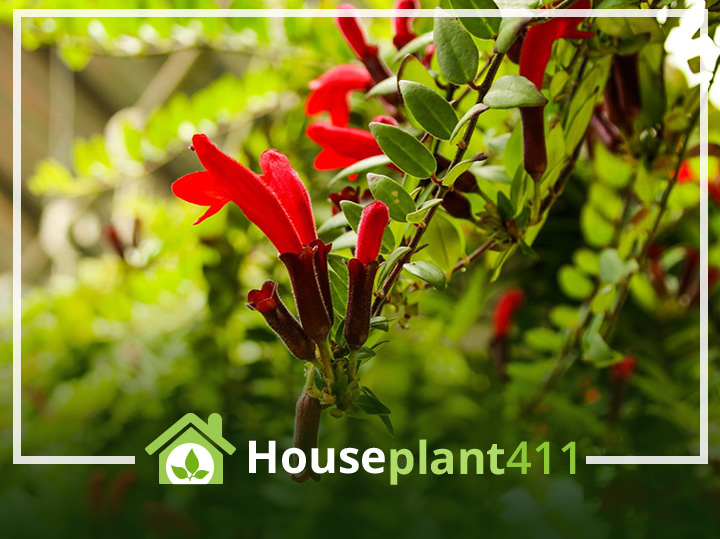A lipstick plant is in the genus Aeschynanthus “pulcher” which means “pretty” or “beautiful” and refers to the vibrantly colored plant flowers. Just to confuse matters, a lipstick plant may also be classified as Aeschynanthus radicans. Lipstick plants were originally found growing in the tropical and subtropical regions of Malesia and Indochina. Although a relative of the somewhat finicky African Violet plant, lipstick plants are easy care, indoor flowering houseplants that look beautiful hanging in a bright spot in your home. If you want a graceful, draping plant that blooms off and on all year, a Lipstick plant is a great choice. These plants do require a great deal of bright, indirect light and high humidity helps them grow even faster.
Lipstick Plant Description
The leaves of a lipstick plant can be light green, dark green, mottled green, green, and maroon, or green with white streaks. Although the leaves are usually elliptically shaped, growing in pairs, and having smooth edges, certain varieties may have wavy, curly leaves. The distinctive looking flowers of a lipstick plant are how the plant got its name. The tubular flowers, which develop in clusters at the ends of the stems, look like tiny tubes of lipstick as they emerge from their dark maroon buds. Lipstick plant flowers can be bright red, orange, yellow, or pink. Although a lipstick plant can surprise us by flowering throughout the year, most blooms appear during the spring and summer. Flowers buds develop on the previous year’s growth, so keep that in mind when pruning the plant.
Lipstick Plant Varieties
Lipstick Plant (Aeschynanthus radicans) know for its long, vines of thick, shiny, green leaves with maroon undersides and bright red, tubular flowers.
Black Pagoda Lipstick Plant (Aeschynanthus longicaulis) has draping stems of mottled green, semi- succulent leaves and tubular flowers in yellow, orange, and reddish orange.
Variegated Lipstick Plant (Aeschynanthus radicans ‘Variegata”) a stunning variety that has white streaked, variegated leaves and produces bright reddish-orange flowers.
Curly Lipstick Plant (Aeschynanthus radicans ‘Curly’) the most unique lipstick plant variety has dark green wavy, curly leaves and produces bright red, tubular flowers.
Mona Lisa Lipstick Plant (Aeschynanthus radicans ‘Mona Lisa’) has very dark green leaves and reddish orange flowers.

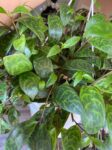
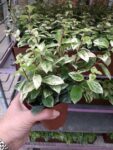
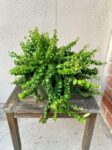
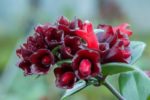
Flowers Black Pagoda Variegated Curly Leaf Flowers
Conclusion
If you have a bright spot in you home or office and want a graceful, draping plant that blooms frequently, a Lipstick plant is a great choice. Hang a vining Lipstick Plant from the ceiling, place it in a wall sconce, or sit one on a table, you will love how they brighten your home throughout the year.
Plant Care
Light
Lipstick plants require very bright indirect light but no direct sun.
Water
Allow the top 25% of the soil to dry out before watering. If the leaves appear soft and shriveled, provide more water. Lipstick plants lose healthy green leaves when over-watered.
Fertilizer
Feed every other week in the spring and summer, and monthly in the fall and winter with a plant food high in phosphorous diluted to 1/2 the recommended strength.
Temperature
A Lipstick Plant grows well in temperatures between 75°- 85°F (24°-29°C)
Humidity
Prefers high humidity but still does well in basic household humidity.
Flowering
When placed in a bright area, a Lipstick plant produces small, reddish orange, pink, or yellow tubular flowers throughout the year. Stressing the plant by allowing the soil to dry out somewhat encourages the plant to bloom. Be careful when you prune, the new flowers on the the stems from the previous year.
Pests
Examine the plant every time you water for mealy bugs, spider mites, aphids, and thrip.
Diseases
When placed in a humid area, a Lipstick plant may get fungal diseases such as leaf spot and botrytis. Keeping the leaves dry and providing good air circulation around the plant helps prevent plant diseases. Reach more about how to identify and treat leaf spot disease and botrytis in the Glossaryof the website.
Soil
Use a well-aerated houseplant soil that drains quickly
Pot Size
A Lipstick plant produces more flowers when kept in a small pots. In larger pots, the plant produces more leaves than flowers.
Pruning
Trim long vines to prevent the plant from becoming thin and straggly, but always remember that flowers develop on the previous years stems.
Propagation
Propagate a Lipstick plant using 4” stem tip cuttings from the newest vines. Read more about how to propagate a plant using stem tip cuttings in the Glossary of the website.
Resting Period
A Lipstick plant produces more flowers in the spring and summer if it has a “rest” during the winter. Move your plant to a slightly cooler area, keep the soil drier, and don’t fertilize until early spring.
Poisonous Plant Info
Lipstick plants are not poisonous and are safe to have around cats, dogs, and small children.
FAQ
To help a lipstick plant get flowers and bloom longer place it in bright indirect light, stress it by under watering a bit, feed with a fertilizer high in potassium, and keep it root-bound.
Thin and straggly lipstick plants need to be aggressively pruned and put it in bright indirect light.
Black spots on the leaves of lipstick plants usually indicate the plant has a fungal disease called botrytis. Quickly cut off the diseased areas before the botrytis spreads to other parts of the plant, and move your plant to a brighter, less humid location that has good air circulation. Keep the leaves dry and keep your diseased plant away from other plants. If the fungal disease returns, spray with a commercial Fungicide.
There could be a couple of reasons why an entire vine on a lipstick plant would dry up and die. First be sure the stem didn’t die because it is broken somewhere along the stem line. If that’s not the problem increase the humidity and give your plant a little more water.

